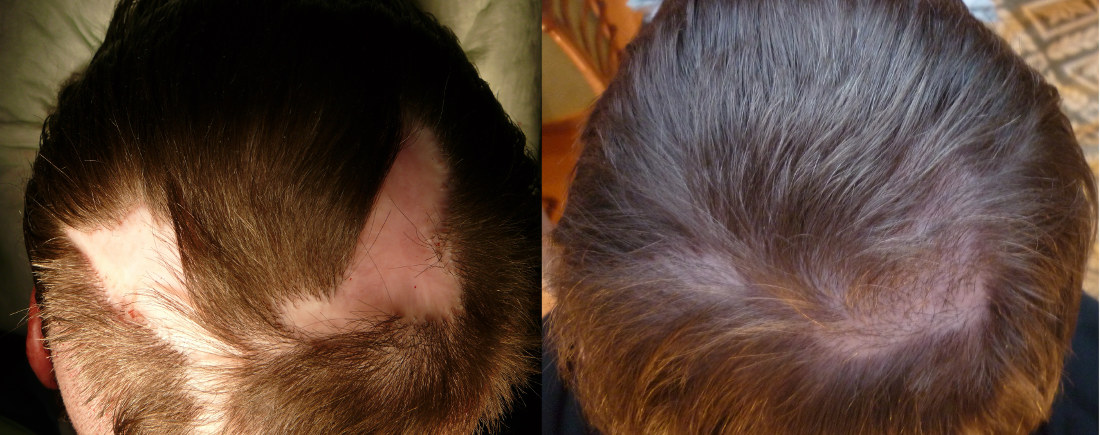Cicatricial hypotrichosis
Variants of surgical correction and the results of treatment (Transplantation into scar tissue)
Since scars in the scalp area are often particularly noticeable, they are not aesthetically pleasing, not only physical, but also psychological discomfort is brought into the life of the person, plastic surgery classifies them as cosmetic defects that are subject to prompt correction. Doctors of the clinic Hairy.ru successfully solve this problem by transplanting hair into damaged scalp tissue.
Scars are dense formations that consist of connective tissue and are formed in the process of regeneration after inflammation or trauma due to mainly collagen. They are qualitatively different from healthy skin, less elastic and durable, more sensitive to ultraviolet radiation, the sweat glands and hair follicles are not restored here. Scars are always formed on the skin, damaged deeper than the epidermis by penetrating wounds, burns, cuts, fungal infection or, for example, microbial (acne, Propionibacterium acnes).

The sequence of scar tissue formation is as follows: inflammation and epithelialization (7-10 days); formation of a "young" rumen (10-30 days); rumen maturation (30-90 days); final transformation (from 4 to 12 months).
Scars differ in appearance, they are normo-, hypo-, atrophic, hypertrophic and keloid. Etiological factors of this skin pathology can be developmental defects (aplasia, ichthyosis and other diseases), hereditary disorders, specific infections (tuberculosis, leprosy, syphilis, leishmaniasis), the final stages of some diseases (lupus erythematosus, sarcoidosis, lichen planus), and of course same, trauma.

So, in order to "hide" the scars, many prefer to grow their hair and create deliberate combings, yet catching the eye; others - use linings, hairpieces, wigs, which is also difficult to hide from others. Transplantation of one's own hair into scar tissue is the most effective and most desirable way for the patient to solve the problem, recreating the natural beauty of the hairstyle, which means that it is aesthetically fully justified. With a skilful execution of the procedure, the result is obvious: where there was a scar, now grow their beautiful hair, hiding it for life.
Transplantation into scar tissue is carried out in two ways: patchwork FUT (FUT / Follicular Unit Transplantation / Follicular Unit Transplantation) and seamless FUE (FUE / Follicular Unit Extraction / TFI / Follicular Isolation Technique).
>
The basis of the patchwork, or strip-method is transplantation into the scars of individual follicular groups - grafts. For the transplant surgeons of the clinic Hairy.ru use minigraphs (2-4 follicles), as well as micrografts containing only one follicle. Grafts are excreted after excision of the donor skin strip from the occipital region of the head. The flap has enough follicular groups to thoroughly close the scar's defect of the patient's scalp.
The FUE method allows the treated follicular groups to be isolated from the occiput with a punch with a diameter of about 1 mm, without excising the donor flap, so the patient does not have a linear scar after the procedure (see "Invisible" FUE: without seams and visible scars "). Miniature grafts of the transplantology of the Hairy.ru clinic are transplanted into the incisions, which were previously deposited in the scar area - pointwise linear wounds. And this method is non-alternative, if the purpose of the operation is a scar after the last FUT operation.

It should be noted that the specific features of the structure of scar tissue affect the survival of the donor material. Statistics show that for healthy skin it is about 90-92%. In the scalp area damaged by the scar, the survival rate ranges from 60% to 70% and above, so to achieve the best cosmetic effect, it may take two to three procedures for transplanting your own hair. Operations for thickening are conducted with an interval of twelve months.
Hair transplantation into the scar is an invasive process that has a number of contraindications in structure, etiology, and age of scar tissue. Thus, it is difficult to guarantee the result of surgical intervention on post-infection scars. Yes, and the scars that appeared as a result of systemic skin diseases, can be operated after a 20-30 graft test transplant with an adherence control after six months. Scar tissue, formed by the removal of tumors, is usually closed by transplanted hair after three years or five years. As for the "age" limitations, the damaged scalp tissues are operated only a year and even later, that is, completely ripe scars.
However, if for any of these reasons hair transplantation into the scar tissue is not indicated to the patient, at the clinic Volosy.ru it is possible to securely hide the ugly scar by resorting to art... tattoos, or trichopigmentation.